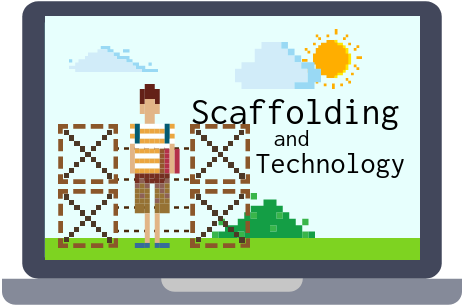By Lisa Carey
November 8, 2017

Scaffolding Basics:
As covered in our last post, scaffolding is a term created by Wood, Burner and Ross(1)to describe the different activities human tutors engage in when trying to assist a child with a task or problem too difficult for them to accomplish with independence. This widely used educational term has come to be applied to such a large variety of instructional activities that it has somewhat lost its true meaning. For the purpose of this post, we are focused on the original meaning of scaffolding, defined as actions taken by a “more competent other” to guide a student’s learning in a one-on-one situation.
When we discuss scaffolding as it was originally defined, we begin to wonder how we can manage a large class of students and provide meaningful guidance on an individual level. In our last post, we pointed to the benefits of peer tutoring, as well as being very considerate of when this instructional technique is most needed and beneficial. Another option for when the student-teacher ratio is too high to provide adequate scaffolding to students is to utilize technology.
How Does Computer-Based Scaffolding Work?
Research into the use of technology for scaffolding goes back to the 1980s, but recent advances in software design and the increase of instructional tech in the modern classroom have improved options for technology embedded scaffolding. In this way, the computer takes on the role of the “more competent other” and guides students through problems and tasks. Examples of instructional computer-based programs with scaffolding include self-paced online modules, instructional games, e-books, digital materials that accompany text-books, videos with embedded materials, as well as teacher-made digital materials.
Computer-based scaffolding comes in several forms: conceptual, strategic, metacognitive, and motivational(2). Conceptual scaffolding relates to software that includes prompts and guidance related to understanding the content a student is engaged with. For example, a student might be engaged with a self-paced module about the animal cells. The software could include elements to help the student comprehend the vocabulary and see how terms and concepts are related to one and other. Strategic scaffolding assists students through planning and problem-solving (you can think of these as executive function supports). For example, as a student works through a problem, software might include guiding questions to support student thinking. Metacognitive scaffolding is similar to strategic, in that is helps navigate student thinking through the use of guiding questions, but rather than focusing on flexible thinking skills, these questions asks students to reflect on their own thinking(3). Finally, motivational scaffolding can include prompts to help students persevere, assistance to reduce frustration, as well as reinforcement for effort toward mastery(2).
The presence and availability of scaffolding can differ among programs. Depending on the software, scaffolding might be automatic and continuously present within the program, performance-adapted so that hints and guiding questions pop up when students begin to struggle, or self-selected by students as they deem the supports necessary(2). Prior to having students use software with scaffolding, it is important to know how they will gain access to the embedded supports. Multiple studies suggest that without direct instruction of how to access self-selected scaffolds, students are unlikely to utilize them appropriately(4).
Does Computer-based Scaffolding Work?
Overall, yes, computer-based scaffolding works, especially if you are choosing between computer-based scaffolding and no-scaffolding(2). A meta-analysis of 144 experimental studies found that students who received computer-based scaffolding performed better than students who received no scaffolding on a variety of assessment types including project-based learning(2). Additionally, no statistically significant differences between automatic, performance-adapted, and self-selected scaffolding was found, indicating that most types software with scaffolding will be helpful to students(2). However, there are some nuances within the literature that we should pay close attention to. In 2006, Gayton found that many students struggle with self-selected scaffolding options(4). The students needed be instructed in how to use the scaffolding features in order to access them. Additionally, Gayton’s literature review points to a concern with low-achieving students being able to independently recognize when they need to utilize available scaffolding options. It should be noted that none of the 144 studies included in the meta-analysis mentioned above included students with disabilities(2). Given this gap in the research, I would caution teachers to follow Gayton’s advice, and directly teach students how to use all computer-based scaffolding, especially if a student has any type of disability that may limit his or her ability to self-monitor and appropriately select when to use computer-based supports.
If we consider scaffolding as it relates to its definition as one-to-one tutoring by a “more competent other,” it is not feasible to expect a teacher to provide scaffolded instruction to a class of thirty students in one lesson. However, through the use of computer-based scaffolding, we can expose students to greater amounts of scaffolding on a more frequent basis. Keep the evidence-based benefits of computer-based scaffolding in mind when selecting digital materials for your students. And don’t forget to share great computer-based scaffolded materials with your colleagues!
References:
- Wood D, Bruner JS, Ross G. the Role of Tutoring in Problem Solving. J Child Psychol Psychiatry. 1976;17(2):89–100.
- Belland BR, Walker AE, Kim NJ, Lefler M. Synthesizing Results From Empirical Research on Computer-Based Scaffolding in STEM Education: A Meta-Analysis. Rev Educ Res [Internet]. 2017 [cited 2017 Oct 24];87(2):309–44. Available from: http://journals.sagepub.com.proxy-tu.researchport.umd.edu/doi/pdf/10.3102/0034654316670999
- Belland BR. Portraits of middle school students constructing evidence-based arguments during problem-based learning: The impact of computer-based scaffolds. Educ Technol Res Dev. 2010;
- Gaytan J. Type II Applications: Using On-Demand Help Features Effectively in Interactive Learning Environments: A Literature Review. Comput Sch. 2006;23(1):163–72.















